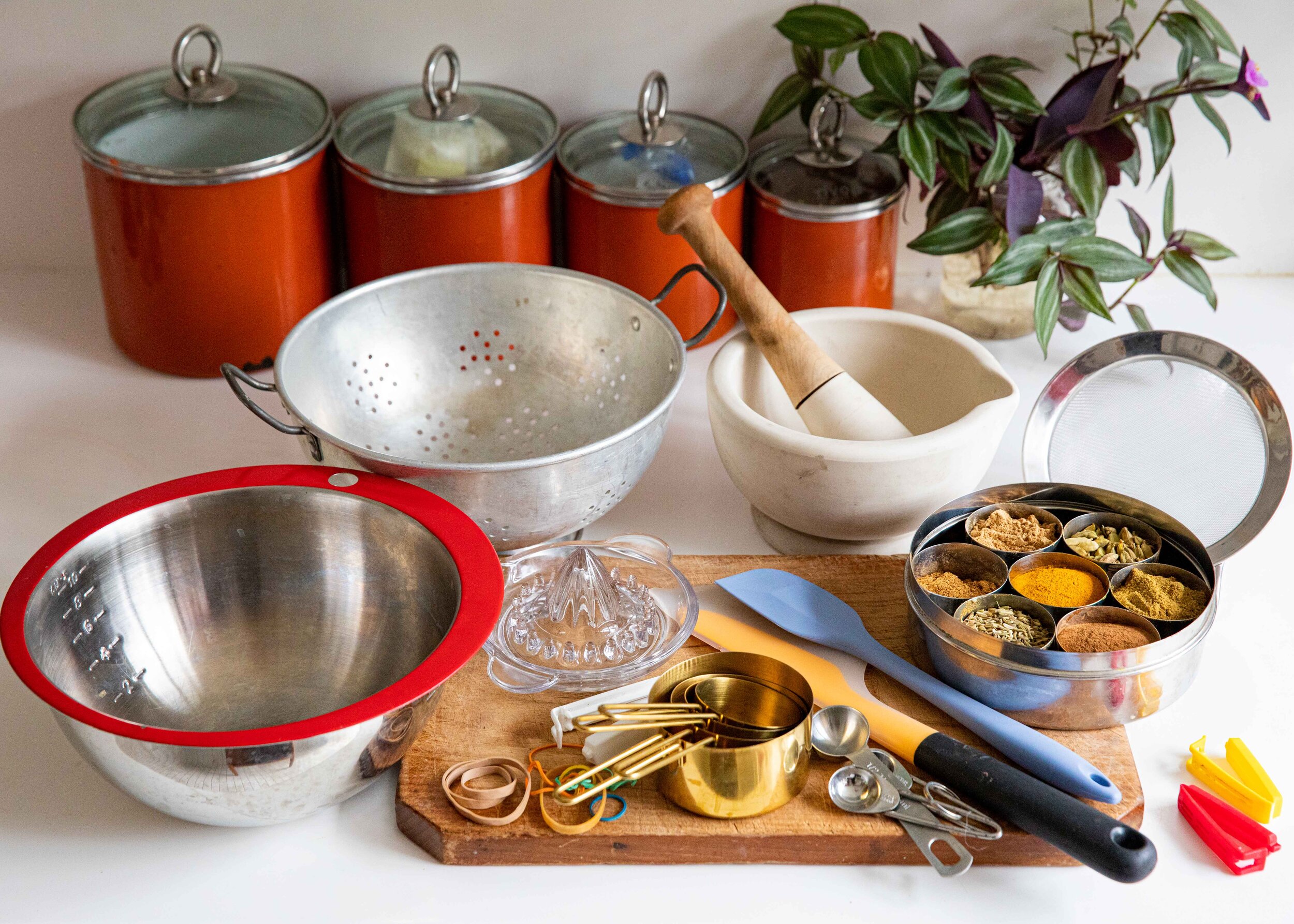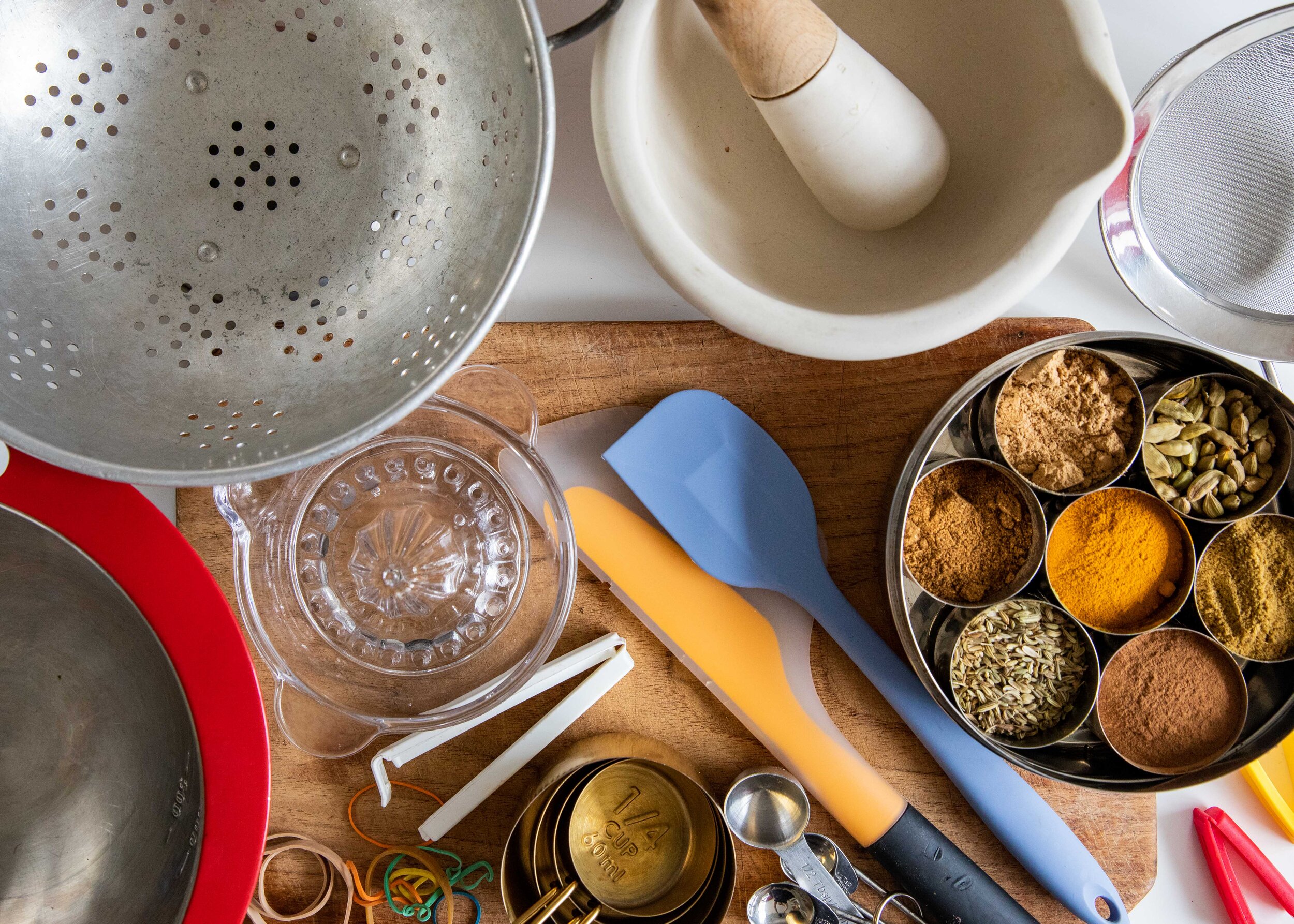10 KITCHEN TOOLS I KEEP AROUND FOR AN EVERYDAY MEAL
I’m definitely no stranger to being asked to cook a meal in other people’s kitchens, having catered for private clients back in the day, and one of the things I love about popping around to friends’ for a cup of tea is the impromptu lunch or dinner that takes place a few hours later as we realise we’re still not done hanging out with each other. As we carry on chatting while examining fridge and cupboard contents and pulling out possible ingredients, I usually know my way around what equipment they have when we get a start on the meal. Kitchen gadgets and utensils are fun if you like cooking or think you might be inspired if you have the right stuff (Lakeland catalogue anyone?) but over the years — and with a much smaller kitchen than I used to have (in my old open plan flat it ended up spilling into the main living space) — I only store the items that come in handy again and again and again. These are the items that I rummage around other people’s kitchens for — OK, none of them are non-negotiable (like a knife, pot, spoon and heat source for example!) when it comes to cooking a meal, but I find myself at a loss without them.
Unless you’ve got the strongest hands in the world (limes can be tough!) and don’t mind picking pips out of food, then a lemon squeezer is a must. I like the classic glass moulded design that I pick up from carboots for anything from 50p to £1 and then distribute to friends who I’ve spotted have the need! Lemon and lime transform a meal — that fresh blast of acidity, zesty freshness, fragrance and tang. Citrus instantly adds one of the 6 Tastes, i.e. sour, taking dal, banana bread, salads... to another level. It’s got to be glass — we don’t want the BPAs and other plasticides found in plastics reacting with the acids — and its brilliant shape catches those pesky pips. It also ensures getting every last drop of juice out of your citrus, preventing food waste (how many not-ripe-enough limes have you tried to get some juice out of?).
OK, if you’re not someone following an Ayurvedic diet or one that uses plenty of spices, then you would be forgiven for wondering why you would need this heavy, chunky bowl taking up kitchen counter space, but if you do want to add a little more pizazz to your kitchen, this guy can make you look and feel the part with little skill. Make your own spice blends by crushing seeds fresh (way more potent in the taste and nutrient department), small portions of pesto, pastes, fresh green chutneys without having to involve a mixer/blender and the subsequent washing up. If you’re working with garlic, I love that it cleans out of the ceramic dish easily without impregnating your chopping board when you’re next slicing fruit. You can also crush nuts and seeds to scatter over dishes — and it’s a brilliant way to make textured pastes where you’re not necessarily after a smooth texture (though you could certainly continue the crushing/grinding action until you get there). Think guac, baba ganoush and hummus.
3. SPATULA
Speaking of crushing, the spatula is what my heart is crushing on. I just find it so satisfying to use. Avoiding the waste of food was massively instilled in me growing up so knowing that a whole cupcake’s worth of batter is still in the mixing bowl or there’s still plenty of jam in a jar to up the breakfast ante irks me when you think that without one of these nifty silicone utensils it would just be going down the sink rather than into your belly. Ever poured your scrambled egg mix into the pan only to come to the washing up afterwards and realise that a whole tablespoon had collected in the bottom while it sat? No more — two swishes of your spatula and every last drop of goodness worth saving is yours. It also makes washing up a much nicer experience.
In your top ten? Really? Yes! This is my pet niggle not to be able to reach for when prepping leafy greens for salads or dry preparations — if you think about it, leafy greens have the highest surface area of any veggies/fruits so will carry the most dust/dirt and pesticide residue if not organic. You'll want to wash your veggies and this makes them soggy. You can swing them in a tea towel around your head all you like but seriously a salad spinner is fun, furious and highly effective. The modern pump action ones are super fast. Yes, it takes up space in the cupboard but it’s worth it — and I use the plastic base bowl and the colander inset for rinsing and washing other items too so it’s always in use. Do look after your salad spinner. As a piece of plastic, be aware that any rough usage will cause it to break and render it useless. Having said that, I've had mine 10 years and counting...
A note on pre-washed salad bags (“washed and ready to eat”): usually manufacturers rinse in a chlorine solution to essentially “disinfect” the leaves for a longer and safer shelf life so you might want to consider washing these again before consuming — we have enough contaminants in our everyday to contend with in the modern world…
Yes to both. A colander for quick water escape of draining beans, veggies, fruits. A sieve for draining soaked quinoa and lentils and seeds, soaked or rinsed rice and the little spice seeds out of your CCF tea. You can also sieve chickpea flour and other flours to get rid of lumps and give them more air (I confess I’m too lazy for this usually) and it’s great for “ricing” potatoes and mashing cooked and fresh tomatoes to remove seeds and skins.
6. SPICE TIN
For when you really get into your spices. I remember prepping my new spice tin for the first time and selected the 7 go-to spices (you can get 9-spice tins too) to take pride of place (basically everything I use in Golden Milk plus cumin and fennel). It makes accessing them quick and easy and helps you get to know your spices by nose and sight — unless you have little labels floating on them like I did in the beginning. It keeps them away from direct sunlight and minimises air exposure to preserve them and means you can buy spices in bulk in baggies rather than new plastic/glass bottles every time.
7. BAG CLIPS + ELASTIC BANDS
OK, I don't cook with these, but I have lived without them and it’s not fun. Opening a packet of baked goods, nuts and seeds or flours, etc. exposes them to moisture and air and makes them lose taste, texture and at worst allows them to go rancid. Having to decant them into jars is nice but it takes up space, costs money (one off for the jars yes), creates more washing up, exposes the product to light (which is a problem too if you don’t use that product often) and you can’t regulate the amount of air in the jar either, whereas in a packet (which conveniently holds the date and info for any non regular ingredients you purchase) you can wrap it up tight and seal it off with a bag clip or band. P.S.: Although bag clips are plastic, I find them way more useful than those little fiddly metal baggy ties that my parents had when I was younger and way more reusable. I bought a big bag of them (multi-size) 15 years ago and am still using the same ones today. As for rubber bands — save them whenever you see them! You might get one with a bundle of post, wrapping herbs from the supermarket. I had a postman prone to dropping them for a period and used to be a weird obsession I had when I went for quick runs around my block; I’d see how many I could find, give them a wash and voilà!
8. MEASURING SPOONS + CUPS
Most of us can get away with our cutlery spoons, teaspoons and mugs to guesstimate ingredient volumes when following recipes, but when it comes to baking or if you’re starting out/not a confident cook (especially smaller portions where it’s easy to over add), a standard set of measuring spoons is an essential. Salt, baking powder and bicarb of soda are some such ingredients you want to be more exact with, and if you’ve ever worked with coconut flour, which expands to 3 times its volume, you’ll know how precise you’ll want to be with that (in fact sometimes when it’s really important for a recipe I use weight measurements for coconut flour for even more accuracy). And with so many international cookbooks which use “cups” as well as or even instead of weight in recipes (I’ve used both in my latest cookbook), it’s good to have them to hand — one cup of this plus one cup of that and half a cup of this is soooo much easier (and easier to remember) than weighing them out: one cup of almond flour and one cup of buckwheat flour are very different weights. Note: American and British cup sizes vary — British are slightly larger, i.e. one American/South African cup is 240g and British is 250g.
It has to be wooden. Glass and marble are a no-no, blunting knives, and the sound of steel hitting that hard surface makes my shoulders tense up. Save glass and marble boards for serving, displaying your creations. Plastic ones — don’t buy them. While plastic chopping boards are a must in professional kitchens — colour coded to separate raw and cooked foods etc., and run through hot dishwashers — every cut releases a microchip of plastic which may enter your food, and the grooves your knife leaves in them collect harmful bacteria.
Wooden boards on the other hand are traditional. Wood is naturally antibacterial, environmentally friendly and looked after well will last a lifetime.
10. BIG BOWL
When prepping veggies and collecting any leftovers destined for the bin, a big bowl makes clean-up as you work a whole lot easier and stops you fiddling with floppy biodegradable bags or having to open and close a food bin (which might already be a bit whiffy with yesterday's food waste, thereby ruining the ambience of your next meal!). I use a stainless steel mixing bowl — light, indestructible, easy to clean and wide enough to swoop my chopping board into without making more of a mess. It’s a really good reminder of how much food waste you make in a day and whether you really need to be tossing the green parts of a leek (don’t! They are really tasty!) or the outer cabbage leaves automatically as a habit. Once the bowl is full, transfer it in one go to a bio bag and close it up tight. Even better if you have a compost heap or wormery, empty your bowl in there. If you have either, check what you can and can’t put in there. I have an enclosed compost heap so I pop everything in without risk of rodents, but cooked foods will attract animals in an open style heap. Wormery worms don’t like things like citrus and lemon so check and separate those out.















